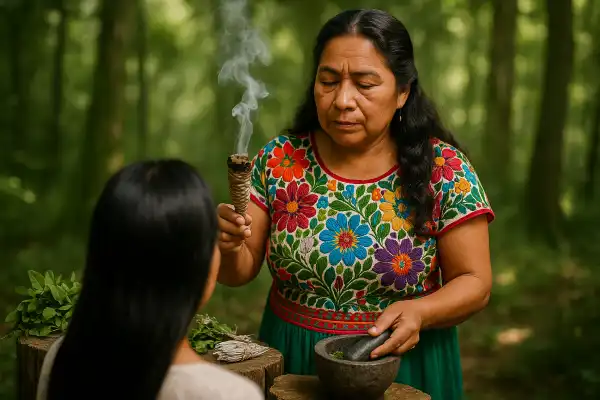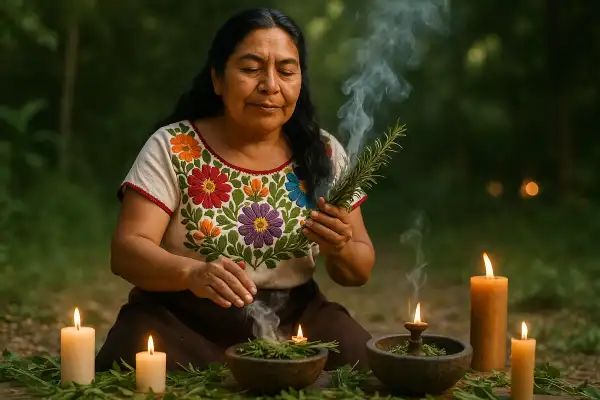Many people seeking authentic healing wisdom find themselves asking what is curandera when they encounter this sacred tradition for the first time. The practice represents centuries of accumulated knowledge passed down through generations of Indigenous Mexican healers.
María del Pilar Fernández, a cultural anthropologist and practitioner deeply rooted in curanderismo traditions, believes that understanding this ancient healing art offers profound pathways to wellness that honor both ancestral wisdom and contemporary needs. She approaches what is curandera not merely as a historical curiosity, but as a living tradition that continues to serve communities seeking holistic healing beyond conventional medicine.
What is curandera?
A curandera is a traditional native healer found primarily in Latin America and the United States, whose practice can either contrast with or supplement that of Western medicine practitioners. The word “curandera” (Spanish: female healer) incorporates the spiritual counseling aspect of the practice, carrying the confidentiality one expects of a “cura” (priest or minister), while also embodying its definition as healer or curer. The curandera practices spiritual healing based upon traditional herbs and remedies, often serving as a respected leader in the local community.

Origins and cultural foundations
Curanderismo represents a healing tradition born from the interaction between Indigenous, Spanish, West African, Arab and Asian medicine ways in Mexico more than 500 years ago. The term curanderismo itself is fairly recent, not coming into prominence until the 1960s or 1970s as a way for academics and outsiders to describe the tradition more cohesively. Before then, it was known simply as nuestra medicina (our medicine), medicina tradicional, remedios, or curas.
Curanderismo survived colonization, resulting in a blend of Mexican indigenous culture and beliefs with Catholic, African, and other influences depending on the healer’s background. Each curandera and curandero develops a distinctive practice most often learned within their family, community, and from elders and teachers.
The divine calling and apprenticeship
It is believed that the ability to heal is primarily a gift (un don) or spiritual calling, and some aspects cannot be taught. Healing is considered a gift from a higher power that may show up in dreams at an early age or be acknowledged by an experienced spiritual elder. In the Hispanic culture, curanderos inherit their healing powers from the previous generation, though sometimes someone outside the family may be blessed with the gift.
Being a curandera is considered a life-long commitment, with the title bestowed by the community in recognition of their abilities and service. Native women do not call themselves curanderas until an elder of their tribe or community gives them the designation, and becoming a curandera requires many years of apprenticeship and practice.
Specializations within curanderismo
Curanderas often develop specific areas of expertise, though many practice multiple specializations:
Yerbera or herbalist
Specializes in the use of herbs, roots, and teas brewed from plant leaves to treat disorders such as diabetes, heart problems, and ulcers. They are deeply knowledgeable about the healing properties of plants and prepare teas, tinctures, poultices, and baths using medicinal plants like chamomile for calming nerves or aloe vera for wounds.
Sobadora or traditional bodyworker
Practitioner who uses Mexican Indigenous-based massage techniques similar to acupressure to treat blockages in the stomach or digestive tract, known as empacho, and constipation. They also target areas where clients experience pain or discomfort. The sobadora uses hands-on healing through massage and acupressure, working especially with the stomach and digestive tract.
Partera or midwife
Traditional birth workers and midwives who use culture-specific practices and methods, providing pre- and postnatal care while incorporating herbs in their practice.
Espiritualista or spiritual healer
Spiritual trance mediums who work primarily with spiritual energy, connecting with spirits or ancestors for guidance. The curandera espiritual uses prayer and ritual and is the least common of the specializations.
Huesero or bonesetter
Trained in the indigenous method of adjusting or setting bones and performing spinal alignment, similar to chiropractors, specializing in muscle and bone manipulation.
Other specializations
Additional types include consejero/consejera (counselors), oracionistas (those who work primarily through prayer), and acupuntarista (practitioners of Mesoamerican acupuncture using culture-specific tools).
Holistic healing approach
In curanderismo, disease is believed to be caused by social, psychological, physical, environmental, and spiritual factors – a disharmony of body, mind, spirit, and nature. Curanderas use healthy and appropriate humor during sessions along with prayer, spiritual cleansings, and healing ceremonies to restore balance and harmony to the body, mind, emotions, and spirit.
Curanderas engage and work on different factors when diagnosing and curing patients, with cultural interventions addressing mind, body, and spirit as interconnected rather than separate. They use various forms of limpias (spiritual cleansings) ranging from copal or sage smoke to ceremonies involving fire, raw eggs, water, candles, limes, sound, and breath.
Conditions commonly treated
Among the illnesses that curanderas help with range from mundane stomach aches to spiritual illnesses such as susto (soul loss from fright), mal de ojo (evil eye), and reversing negative spiritual influences. Curanderas are considered the only healers in the culture who can treat mal puesto – illnesses caused by witchcraft.
Traditional healing rituals include treatments for caida de mollera (fallen fontanelle), limpias (spiritual cleansings), and the use of medicinal plants like romero (rosemary), ruda (rue), albahaca (basil), sabila (aloe vera), and yerbabuena (mint).
Contemporary relevance
Traditional healing practices among Mexican and Mexican Americans may be as high as 50-75% in some parts of the United States. Shifting cultural views have made it safer for healers to come “out of the curandera closet” and for those sifting through memories of family remedios and curas to reconnect with their roots.
Modern curanderas encourage a thoughtful inclusion of traditional Indigenous healing practices alongside conventional medical treatments as appropriate, seeking to educate healthcare providers about Mexican Indigenous healing ways. Students can learn to reclaim a part of a tradition that has been around for years, as their grandmothers knew about traditional medicine and used herbs for healing.
Disclaimer
Please note that Maria is not a physician, psychologist, or nurse. These culture-specific spiritual healing services are not meant to replace medical or psychological diagnosis and treatment. It is recommended that you see a licensed physician or licensed health care professional for any physical or psychological ailment you may have.
Recently, María worked with a young woman named Catalina who came to her suffering from persistent nightmares and a heavy feeling in her chest that no doctor could explain. After careful listening during their plática, María recognized the symptoms of susto – a spiritual condition where the soul becomes displaced due to sudden fright or trauma. Catalina revealed she had been in a car accident months earlier and, while physically unharmed, had never felt quite herself since.
María prepared a cleansing ritual using ruda and white sage, guiding Catalina through breathing exercises while calling her spirit back home. She also prescribed a tea blend of manzanilla and toronjil to calm her nervous system and recommended Catalina visit the place of the accident to formally release her fear. After three sessions, Catalina reported that her nightmares had ceased and the weight in her chest had lifted. However, María was careful to ensure Catalina continued working with her physician to monitor her overall health, understanding that true healing honors both traditional wisdom and modern medicine.

